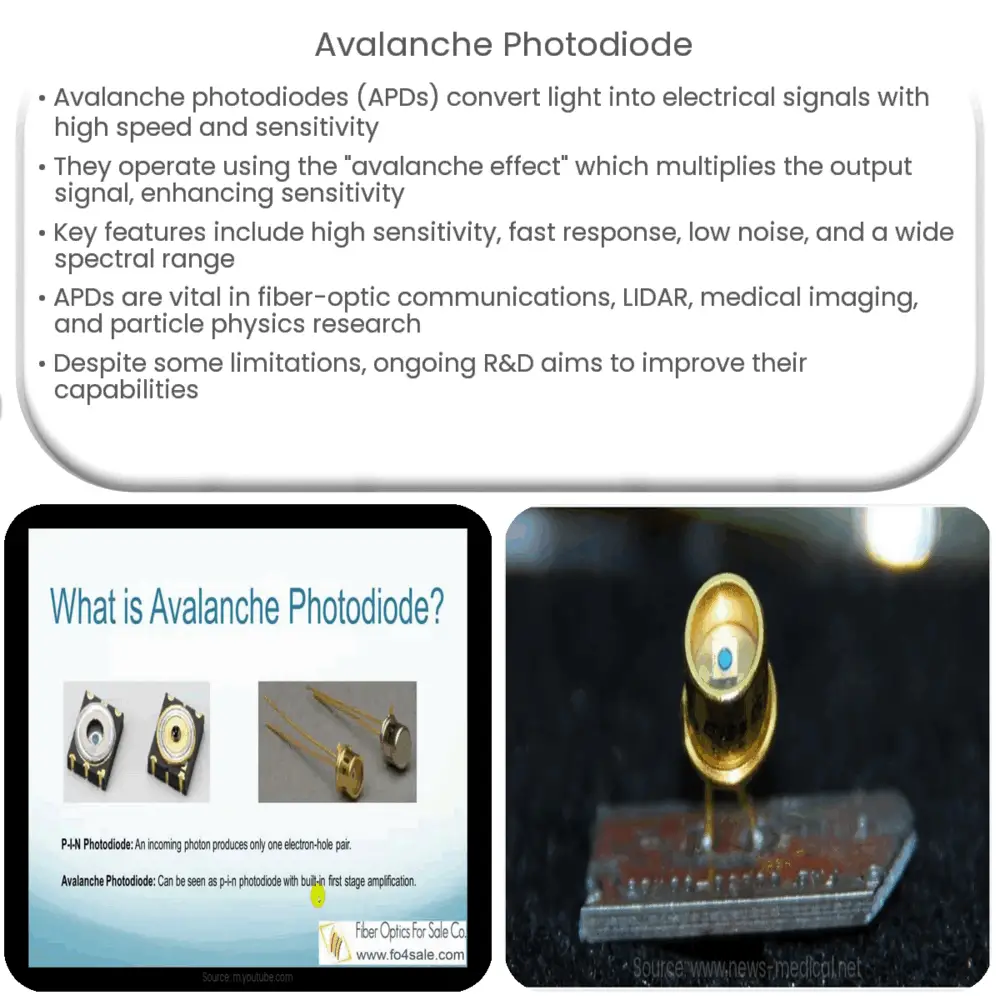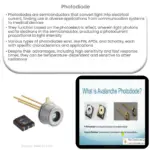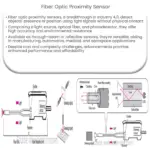Avalanche photodiodes (APDs) are high-speed, sensitive semiconductor devices that convert light into electrical signals for diverse applications.

Avalanche Photodiode: An Overview
Introduction
Avalanche photodiodes (APDs) are semiconductor devices that are specifically designed to convert light into electrical signals with high speed and sensitivity. These photodiodes are commonly used in a wide range of applications, such as fiber-optic communication systems, LIDAR, medical imaging, and particle physics research. This article provides an overview of avalanche photodiodes, including their working principle, key features, and applications.
Working Principle
APDs operate on the principle of the “avalanche effect,” which involves the generation of a large number of electron-hole pairs through the process of impact ionization. In an APD, a photon of light entering the device creates an electron-hole pair. When a reverse bias voltage is applied to the device, the generated electron and hole are accelerated by the electric field, causing them to gain enough energy to create additional electron-hole pairs through impact ionization. This multiplication process is known as the avalanche effect and results in a significant increase in the output signal, improving the photodiode’s overall sensitivity.
Key Features
There are several features that set avalanche photodiodes apart from other types of photodetectors:
- High sensitivity: Due to the avalanche effect, APDs are capable of detecting very low light levels. This makes them suitable for applications where weak light signals need to be detected.
- Fast response time: APDs can respond to light signals within a few nanoseconds, making them ideal for high-speed applications such as fiber-optic communications and time-of-flight measurements.
- Low noise: The avalanche process can be carefully controlled to minimize noise, resulting in a high signal-to-noise ratio (SNR) for the detected light signal.
- Wide spectral range: APDs are available in various materials, allowing them to detect light across a broad range of wavelengths. Silicon (Si) APDs are commonly used for visible and near-infrared detection, while indium gallium arsenide (InGaAs) APDs are used for longer wavelengths.
Applications
Avalanche photodiodes are used in numerous applications due to their high sensitivity, fast response time, and low noise characteristics. Some of the most common applications include:
- Fiber-optic communication systems: APDs are used as receivers in long-haul and high-speed optical communication networks. Their ability to detect low-level light signals makes them crucial for maintaining signal integrity over long distances.
- LIDAR: Light detection and ranging (LIDAR) systems rely on APDs to accurately measure distance and generate high-resolution 3D images for various applications, such as autonomous vehicles, topography mapping, and atmospheric research.
- Medical imaging: In medical imaging applications, such as positron emission tomography (PET) and single-photon emission computed tomography (SPECT), APDs are used to detect low-intensity gamma rays with high sensitivity and precision.
Particle Physics Research
Particle detectors: APDs play a crucial role in the detection of high-energy particles in research facilities like the Large Hadron Collider (LHC). They are used to detect photons produced during particle collisions, enabling scientists to study fundamental particles and their interactions.
Advantages and Limitations
Despite their numerous benefits, avalanche photodiodes also have some limitations:
- Temperature dependence: APDs are sensitive to temperature changes, which can affect their performance. Temperature variations can influence the avalanche multiplication factor and lead to increased noise. This issue can be mitigated by using temperature stabilization techniques or incorporating cooling systems in the device.
- High operating voltage: APDs require a high reverse bias voltage to achieve the avalanche effect. This requirement can lead to increased power consumption and may necessitate additional voltage regulation components in the system design.
- Cost: APDs are generally more expensive than other photodetectors, such as PIN diodes, due to their complex fabrication process and the need for additional components to manage temperature and voltage.
Future Developments
Research and development efforts continue to focus on improving the performance of avalanche photodiodes and expanding their range of applications. Some notable areas of development include:
- New materials: Scientists are exploring new semiconductor materials to enhance the performance of APDs. For example, research into germanium-tin (GeSn) alloy-based APDs aims to improve sensitivity in the mid-infrared range, opening up potential applications in environmental sensing and chemical analysis.
- Integration with other technologies: Researchers are working on integrating APDs with other components, such as waveguides and modulators, to create highly efficient, compact photonic integrated circuits (PICs) for applications in telecommunications, data centers, and sensing.
- Advancements in manufacturing techniques: As the demand for APDs grows, new manufacturing techniques are being developed to reduce production costs and increase yield. This could potentially lower the price of APDs and make them more accessible for a broader range of applications.
Conclusion
Avalanche photodiodes are versatile and powerful photodetectors that offer high sensitivity, fast response times, and low noise. Despite some limitations, such as temperature sensitivity and high operating voltage requirements, APDs continue to find widespread use in various applications, including fiber-optic communications, LIDAR, medical imaging, and particle physics research. Ongoing research and development efforts promise to further enhance their performance and expand their range of applications in the future.




